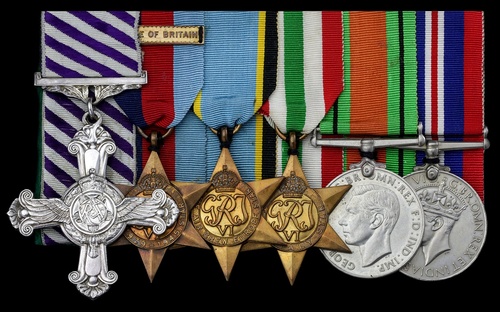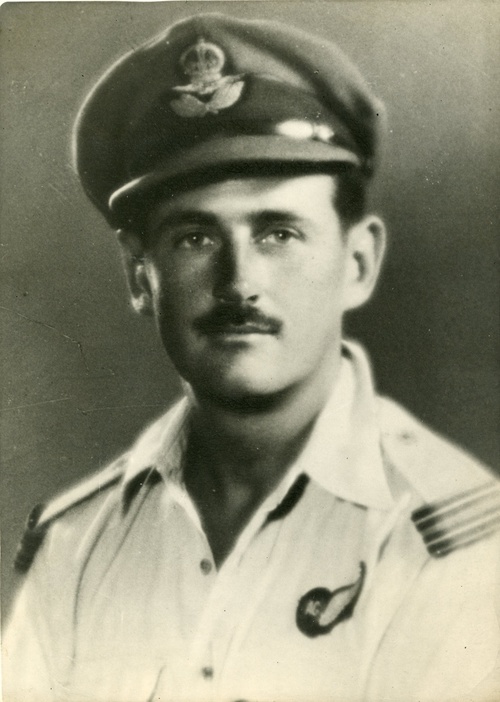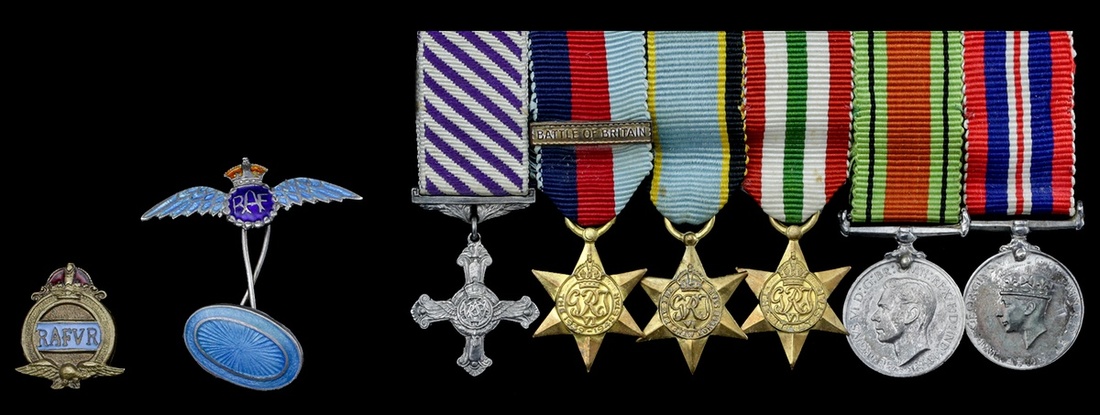Auction: 19003 - Orders, Decorations and Medals
Lot: 314
A fine Second World War D.F.C. and ‘Battle of Britain’ group of six awarded to Flight Lieutenant D. M. A. Smythe, Royal Air Force, who flew during the Battle as an Air Gunner in obsolete Defiant aircraft of No. 264 Squadron and later witnessed extensive bombing and strafing sorties in Italy with No. 223 Squadron, being awarded the D.F.C. for ‘determination and devotion to duty over a very long period of operational flying’ as Gunnery Leader in Baltimore light attack bombers
Distinguished Flying Cross, G.VI.R., the reverse officially dated ‘1944’ and additionally privately engraved ‘79196 D.M.A. Smythe 223 Sqdn.’; 1939-45 Star, copy clasp, Battle of Britain; Air Crew Europe Star; Italy Star; Defence and War Medals 1939-45, court-mounted, very fine and better (6)
D.F.C. London Gazette 14 November 1944.
The original recommendation for the non-immediate award of the D.F.C. - by Acting Wing Commander Kenneth Frederick Mackie, D.F.C. & Bar, Officer Commanding, No. 223 Squadron - states:
‘Flight Lieutenant Smythe has now completed 160 operational sorties, totalling 334 operational hours during two operational tours of flying. In practice, this has been over one long operational tour, instead of two, as he has had no rest period since he started operational flying in November, 1940.
Between November, 1940 and December, 1943, Flight Lieutenant Smythe carried out 113 operational sorties on Defiant night fighters with Fighter Command in the United Kingdom, and in January of this year flew out to Italy, joining No. 223 Squadron as my own gunner on Baltimore aircraft on 20 January, 1944.
During the six months he has flown with me he had continual stomach trouble of varying intensity, but, in spite of this, he refused to go into hospital or to miss a single raid. He has flown with me as Leading Gunner of Squadron formations on 33 occasions and of Second boxes on seven, during a long period of strain and a change-over of Observer and W/Op. Air members of my crew.
He has been Gunnery Leader of this Squadron during this period and by his drive, sound knowledge and experience with Fighter Command, has commanded the respect of the other Gunners and had contributed to a marked degree towards their efficiency and high morale.
Although we have not encountered any enemy fighter opposition, as Leading Gunner he has directed me in evasive action against often severe Ack-Ack fire with such coolness and skill that no aircraft has been lost when he has been Leading. By his personal example and continuous strict supervision of the gunnery side of this Unit, he has been an inspiration and asset to all the aircrew.
Strongly recommended for the award of the Distinguished Flying Cross for determination and devotion to duty over a very long period of operational flying.’
The covering remarks by the Air Officer Commanding, No. 3 Wing, S.A.A.F., Lieutenant-Colonel O. Galgut, state:
‘Although Flight Lieutenant Smythe has only completed 47 sorties whilst with No. 223 Squadron, he previously completed 113 sorties in the United Kingdom. During his period of service with No. 223 Squadron he flew as Leading Gunner on 33 occasions. He showed keenness, enthusiasm and devotion to duty far beyond average and the award of the Distinguished Flying Cross is strongly recommended.’
Derek Myles Altamont Smythe was born on 26 June 1914 at Pretoria, Gauteng, South Africa, the son of John James Robert Smythe and Ethel Mary Sophy Grayson; he was the husband of Julia J. O’Sullivan whom he married in June 1935 at Battersea, London.
Smythe joined the Royal Air Force Volunteer Reserve on a direct-entry commission as an Air Gunner on 20 April 1940 and carried out his gunnery training at No. 1 Air Armament School at Manby, completing the Air Gunner’s Course there on 12 June 1940. Having been graded a ‘proficient Air Gunner’ on Battles, Demon and Blenheim aircraft, Smythe was appointed Acting Pilot Officer and posted on 20 May 1940 to ‘B’ Flight of No. 98 Squadron, equipped with the single-engine Fairey Battle light bomber.
His first operational flight took place that same day, when acting as rear gunner to Pilot Officer Shuttleworth flying out of Nantes Aerodrome. That afternoon he flew in Battle K9219 piloted by Sergeant Leslie Charles Allton, a pilot who died over Maidstone during the Battle of Britain, not through enemy action but most likely through oxygen failure - his Spitfire being seen to fall out of formation and enter a spiral dive. Smythe flew on six more occasions from the training establishment at Nantes, but the success of the German Blitzkrieg and rapid retreat of the British Army towards the beaches of Dunkirk led to the evacuation of the Squadron. On 1 June 1940 Smythe flew across the Channel and likely witnessed the stream of Royal Navy, Merchant Navy and ‘little ships’ craft engaged in Operation Dynamo; among those who would never return home were 75 men of No. 98 Squadron, R.A.F., who died when H.M.T. Lancastria was bombed and sunk off the French port of St. Nazaire by Ju. 88s of Kampfgeschwader 30 on the afternoon of 17 June 1940. Many of those who weren’t drowned within the holds when the ship went down were killed when ‘German aircraft began strafing survivors in the water and dropped flares into the floating oil’ (The Sinking of the “Lancastria”: Britain’s greatest maritime disaster and Churchill’s cover-up, refers).
On 18 June 1940, Smythe was posted to No. 5 O.T.U. at Ashton Down. It was here that he received further trainning as an Air Gunner, firstly on Blenheims and latterly, from 30 June 1940 on the Boulton Paul Defiant interceptor aircraft. Known affectionately by it’s aircrew as ‘The Daffy’, the Defiant looked similar to a Hurricane and used the same Rolls Royce Merlin engine, but there the similarities ended. With an air speed more than 100 miles per hour slower than a Me. 109, and with no forward firing guns, rather a reliance upon an an electrically operated ‘ball turret’ located behind the pilot, it was exceptionally vulnerable in daylight to enemy fighters. Furthermore, the Defiant had a blind spot beneath the tail – from where enemy fighters could deliver the coup de grace.
Such weaknesses had been made clear in February 1940 when the Commanding Officer of No. 264 Squadron flew a Defiant on combat manoeuvres against Robert Stanford Tuck in a Spitfire; it soon became clear that against experienced opposition, the Defiant could only defend itself by circling and keeping its speed up, its abilities suited only to performing bomber-destroyer duties (Raymond Bowyer, refers).
Nevertheless, Smythe was posted to No. 264 Squadron at R.A.F. Duxford under the command of Squadron Leader Philip Hunter on 6 July 1940. He joined ‘B’ Flight on a sortie with Pilot Officer Hugh Percy on 13 July 1940, and flew an interception patrol in low cloud and heavy rain over Orford Ness two days later. On 19 July 1940, Percy and Smyth patrolled over Harwich; at about noon, just a few days after the commencement of the Battle of Britain, nine Defiants of No. 141 Squadron took off from Hawkinge on a routine patrol, most of them crewed by crewed by New Zealanders. Flying at 5,000 feet, they were ‘bounced’ by a vastly superior force of Me. 109s who came out of the sun. Of the nine Defiants, four crashed into the Channel killing their eight crew, a fifth crashed into the White Cliffs of Dover and a sixth crashed trying to return to base. The scale of the mauling led to media coverage being hushed-up for the sake of national security and morale, but secret reports described it as a ‘massacre’. As a result, all 1,000 Defiant aircraft were later transferred from day to night-flying duty. This may explain No. 141 Squadron’s Latin motto ‘Caedimus Noctu’ (We Slay by Night), which gained relevance not at formation on 1 January 1918 and during home service in the latter stages of the Great War, but following the events that day.
On 23 July 1940, the Squadron moved to Kirton Lindsey where they received a visit by Winston Churchill and Marshal of the R.A.F, Sir Cyril Newall. The experienced aircrews furthermore used this time as an opportunity to perfect a technique called the ‘Luftberry’, which enabled them to repel the faster enemy fighters by conducting a complicated manoevre involving forming quickly into a circle and descending, so that the Messerchmitt’s could not fly in front or beneath them. On 6 and 7 August 1940, Percy and Smythe conducted convoy patrols. On 11 August 1940 they were scrambled to intercept a Ju. 88 over Ringway, but could not catch up with the enemy bomber. Further convoy patrols followed, but with no contacts being made.
Transferred to Hornchurch on 21 August 1940, Smythe flew on a patrol over R.A.F. Manston three days later, just 30 minutes after the airfield had been on the receiving end of a substantial raid by Ju, 88s and Me 109s. A series of individual combats were taking place overhead, but despite their eagerness Smythe was made to remark in his log book, ‘Numerous He 113s attacked but they would not engage’. That morning No. 264 Squadron claimed three Ju. 88s destroyed, one damaged and one He. 113 destroyed, for the loss of four Defiants in action and a further two lost in a collision on take-off. After a hurried lunch the Squadron were ordered up to meet another attack, and it was on this occasion that the Commanding Officer, Squadron Leader Philip Hunter, D.S.O., was last seen chasing an enemy bomber out to sea (The Few: The Story of the Battle of Britain in the Words of the Pilots, refers).
Exactly why the Defiants of No. 264 Squadron were sent up in force on this day has never been fully explained, as it was only a month previously that No. 141 Squadron had been decimated, and by the end of the day No. 264 had lost six aircraft.
Similar heavy losses sustained whilst engaged on patrol duties forced Fighter Command to allocate No. 264 Squadron a purely night-fighter role from 27 August 1940, with the occasional cover of convoys in the Channel. Percy and Smythe flew their first operational night patrol on 7 September, being engaged for a number of days in patrolling the skies above Northolt at 15,000 feet. On 20 September, Percy and Smythe lost R/T contact 30 minutes into their patrol and became lost, only finding their way back to base ‘by absolute fluke’ (his Log Book, refers); they continued regular patrols, before Smythe was posted to the Central Gunner School at Warmwell from 12 December 1940-5 January 1941.
On 17 January 1941 Smythe returned to ‘B’ Flight with No. 264 Squadron, now operating out of Biggin Hill. Seving on his first night patrol in Defiant P 3313 with Flying Officer Percy on 15 February 1941, Smythe noted in his logbook ‘chased invisible bandit half way across Channel’. On 23 February he added on a similar patrol, ‘sat over Boulogne at 22,000 feet, getting pasted by our bombers’. In March and April, Smythe and Percy flew regular night patrols from Biggin Hill and West Malling, Smythe noting in his log the ‘bad Blitz on London’. In July 1941 they conducted a ‘Turbinlite-Havoc’ operation, where a Douglas Havoc night-fighter equipped with a searchlight in its nose attempted to illuminate the enemy bombers, hopefully to be shot down by the Defiants. Five more similar patrols were conducted in August.
It was whilst flying over Dungeness in Kent that Smythe experienced a close shave when his aircraft was mistakenly attacked by Spitfires on 5 April 1942. Promoted Flight Lieutenant on 14 May 1942, he transferred to No. 515 Squadron and was ordered on 26 September 1942 to R.A.F. Zeals in order to participate in any future attacks on the Scharnhorst and Gneisenau capital ships which were being repaired in the Baltic ports. Between January and July 1943 Smythe completed over 30 ‘Ops’ with No. 515 Squadron and was then posted to No. 307 Ferry Training Unit at R.A.F. Finmere, Buckinghamshire.
Transferred to No. 223 Squadron on 20 January 1944, he later acted as Gunnery Leader operating Baltimore’s from Celone, Italy. His logbook details 47 operations, the majority of them involving missions to bomb factories, railheads, a railway tunnel to the west of Praetola and road junctions. On 31 March 1944 he bombed the San Benedetto railway and on 7 April 1944 he attacked the Papigno hydro-electric plant. Later targets included gun positions near Ponte Corvino and the Wharf’s at Ravenna – where his aircraft met heavy flak. On 12 August 1944, Smythe returned home from Pescara to Cairo and on to England via Malta, for a well-earned rest.
Smythe saw out the end of the War attached to No. 45 Group Transport Command at Dorval, Canada, where he served as Group Accidents’ Investigator. He was released from the R.A.F. in March 1946, his log book recording a total of 1055 hours’ flying time.
He married for a second time in April 1952, living with his wife Patricia Day at 59 Ladbroke Grove, London, W.11, and died in December 1999 at Sleaford, Lincolnshire.
To be sold with the following documentation and ephemera:
(i)
Original R.A.F. Observer’s and Air Gunners Flying Log Book, detailing the recipient’s full period of service from 27 April 1940-3 February 1946. This is worn at the spine and fragile, the first page recording ‘Certificates of Qualification’ being separate, but the log is complete and gives a good account of the recipient’s service during the Second World War.
(ii)
The miniature dress medals worn by the recipient and swing mounted by Spink & Son Ltd, comprising: Distinguished Flying Cross, G.VI.R.; 1939-45 Star, clasp, Battle of Britain; Atlantic Star; Italy Star; Defence and War Medals 1939-45.
(iii)
A Silver and blue enamel R.A.F. cufflink, together with contemporary R.A.F.V.R. pin badge and Air Gunner’s embroidered brevet.
(iv)
A comprehensive copied research file, including original photographs of the recipient as a child and in R.A.F uniform; a number of fascinating photographs of the recipient about to enter the turret of his aircraft and further images of the recipient and his wife (approx. 16 photographs).
Subject to 20% VAT on Buyer’s Premium. For more information please view Terms and Conditions for Buyers.
Estimate
£3,500 to £4,500
Starting price
£2400









